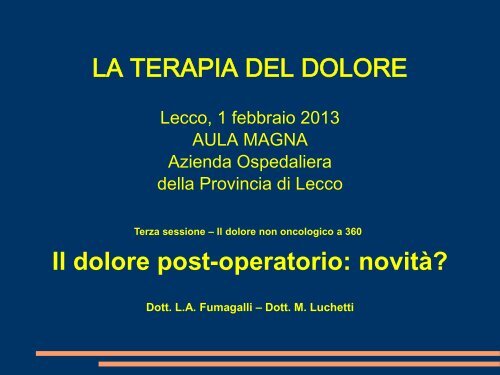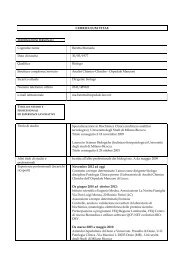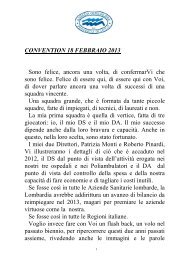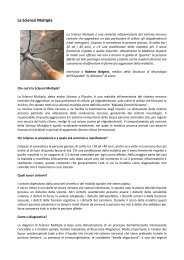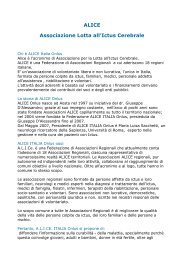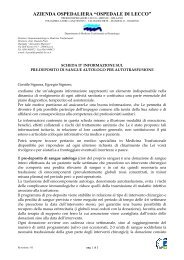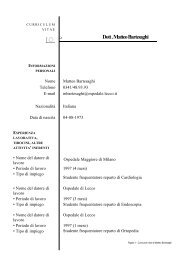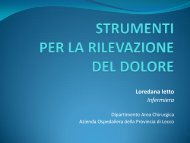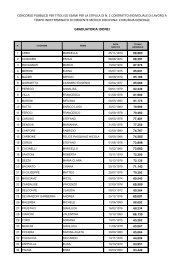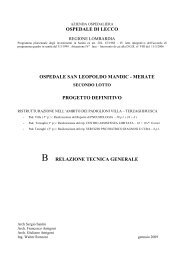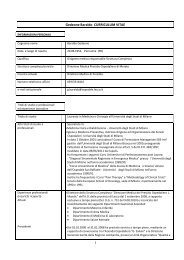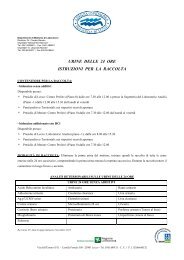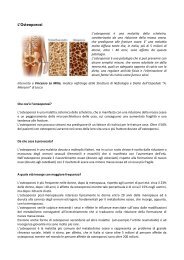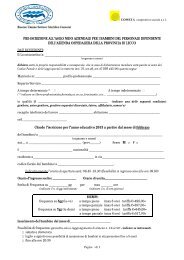Slide La terapia del dolore: L.A. Fumagalli
Slide La terapia del dolore: L.A. Fumagalli
Slide La terapia del dolore: L.A. Fumagalli
Create successful ePaper yourself
Turn your PDF publications into a flip-book with our unique Google optimized e-Paper software.
LA TERAPIA DEL DOLORE<br />
Lecco, 1 febbraio 2013<br />
AULA MAGNA<br />
Azienda Ospedaliera<br />
<strong>del</strong>la Provincia di Lecco<br />
Terza sessione – Il <strong>dolore</strong> non oncologico a 360<br />
Il <strong>dolore</strong> post-operatorio: novità?<br />
Dott. L.A. <strong>Fumagalli</strong> – Dott. M. Luchetti
Dolore Somatico e Dolore Viscerale<br />
Recettori specifici ad alta densità:<br />
Merkel, Ruffini , Pacini<br />
– Localizzazione spaziale<br />
– Superficiale<br />
• cute<br />
– Profondo<br />
• articolazioni<br />
• Fibre A mieliniche<br />
– Discriminante, netto<br />
acuto, puntorio<br />
• Recettori comuni a bassa<br />
densità: intraganglionic laminar<br />
endings (IGLEs)<br />
intramuscular arrays (IMAs)<br />
– Diffuso<br />
– irradiato<br />
– Riferito (a<br />
metameri)<br />
• Fibre C amieliniche<br />
– Poco localizzato<br />
– Diffuso, profondo,<br />
urente, persistente
DNS Darmnervensystem<br />
(plesso mienterico);<br />
NDNV Nucleus dorsalis<br />
nervi vagi;<br />
NTS Nucleus tractus<br />
solitarii<br />
LS Sistema Limbico
DOLORE VISCERALE<br />
• “commonly associated with greater<br />
emotional valence and exaggerated<br />
autonomic reflexes”<br />
– Pallore (vascostrizione, ipotermia cutanea)<br />
– Tachicardia<br />
– Sudorazione<br />
– Midriasi
Sympathetic ganglia<br />
Paravertebral ganglia
Interazioni: risposta da stress<br />
asse “Hypothalamus Pituitary Adrenal”<br />
(Ipotalamo Ipofisi Surrene)
Interazioni NeuroImmunoEndocrine<br />
Nervous, endocrine, and immune subsystems communicate<br />
dynamically using the language of common chemical substances
Modulazione <strong>del</strong> <strong>dolore</strong><br />
(inibizione/amplificazione)
Dolore postoperatorio<br />
(chirurgia viscerale)<br />
• Componente Somatica (parete<br />
toracica/addominale)<br />
• Attivazione HPA<br />
• Componente Viscerale (sierose)<br />
– Componente Tissutale (distruzione)<br />
• Attivazione Flogistica (attivazione SIRS,<br />
coagulazione)<br />
– Componente Immunologica<br />
• inibizione attività cellulomediata;<br />
• attivazione immunità fagica
Controllo <strong>del</strong> <strong>dolore</strong> postoperatorio<br />
(chirurgia viscerale)<br />
• Componente Somatica (parete<br />
toracica/addominale)<br />
• Attivazione HPA<br />
EPIDURALE?<br />
• Componente Viscerale (sierose)<br />
– Componente Tissutale (distruzione) FANS<br />
• Attivazione Flogistica (attivazione SIRS,<br />
coagulazione)<br />
OPPIOIDI<br />
– Componente Immunologica<br />
• inibizione attività cellulomediata;<br />
• attivazione immunità fagica<br />
VATS, VLS ?<br />
I.P. LOCAL AN. ?
Dolore postoperatorio<br />
(chirurgia viscerale)<br />
• Componente Somatica (parete<br />
toracica/addominale) -chirurgia mininvasiva<br />
• Attivazione HPA<br />
• Componente Viscerale (sierose)<br />
– Componente Tissutale (distruzione)<br />
• Attivazione Flogistica (attivazione SIRS, coagulazione)<br />
– Componente Immunologica<br />
• inibizione attività cellulomediata;<br />
• attivazione immunità fagica
SILC appears to be a safe, feasible technique with potential<br />
advantages of cosmesis, reduced incisional pain, and well-being<br />
recommending its use. These data indicate no difference in<br />
systemic stress and morbidity between SILC and LC.
Dolore postoperatorio<br />
(chirurgia viscerale)<br />
• Componente Somatica (parete<br />
toracica/addominale)<br />
• Attivazione HPA – An. Epidurale<br />
• Componente Viscerale (sierose)<br />
– Componente Tissutale (distruzione)<br />
• Attivazione Flogistica (attivazione SIRS,<br />
coagulazione)<br />
– Componente Immunologica<br />
• inibizione attività cellulomediata;<br />
• attivazione immunità fagica
L'Analgesia peridurale<br />
inibisce la risposta neuro-ormonale<br />
ma non inibisce<br />
la risposta infiammatoria acuta da stress<br />
in seguito a prostatectomia radicale
cortisolo glicemia insulinemia
Dolore postoperatorio<br />
(chirurgia viscerale)<br />
• Componente Somatica (parete<br />
toracica/addominale)<br />
• Attivazione HPA: MIGLIORA LA<br />
PROGNOSI?<br />
• Componente Viscerale (sierose)<br />
– Componente Tissutale (distruzione)<br />
• Attivazione Flogistica (attivazione SIRS,<br />
coagulazione)<br />
– Componente Immunologica<br />
• inibizione attività cellulomediata;<br />
• attivazione immunità fagica
In conclusion, we found a significantly lower<br />
mortality in patients receiving an epidural for<br />
management of postoperative pain and operated for<br />
rectal but not colonic cancer, compared with those<br />
having patient-controlled morphine analgesia.<br />
These differences between rectal and colonic cancer<br />
could be due to the type of tumour and the<br />
protective effects of an epidural on the<br />
neuroendocrine response to surgery.<br />
Prospective, randomized studies are needed to<br />
answer the exact role of epidurals in preventing<br />
cancer-related morbidity and mortality during<br />
colorectal Surgery.
Dolore in chirurgia viscerale<br />
• Componente Somatica (parete<br />
toracica/addominale)<br />
• Attivazione HPA<br />
• Componente Viscerale (sierose)- ANEST. LOC.<br />
INTRAPERITONEALE<br />
– Componente Tissutale (distruzione)<br />
• Attivazione Flogistica (attivazione SIRS,<br />
coagulazione)<br />
– Componente Immunologica<br />
• inibizione attività cellulomediata;<br />
• attivazione immunità fagica
We conclude that the use of intraperitoneal local anesthesia is safe, and it results in a<br />
statistically significant reduction in early postoperative abdominal pain.
Dolore nel paziente acuto<br />
Componente Viscerale (sierose)<br />
Componente Tissutale (flogosi, ischemia, necrosi)<br />
Attivazione Flogistica (attivazione SIRS,<br />
coagulazione)<br />
Componente Immunologica<br />
inibizione attività cellulomediata, attivazione immunità<br />
fagica<br />
Attivazione HPA<br />
Componente Somatica<br />
(parete toracica/addominale)
Gestione <strong>del</strong> Dolore<br />
nel paziente acuto<br />
• Vedere e Riconoscere il <strong>dolore</strong><br />
• Discriminare la tipologia e l'entità <strong>del</strong> <strong>dolore</strong><br />
• valutare l'entità emotiva (soggettiva) e l'entità<br />
riflessa (autonomica) <strong>del</strong> <strong>dolore</strong><br />
• Misurare l'entità soggettiva <strong>del</strong> <strong>dolore</strong><br />
• Prendere le misure Diagnostiche <strong>del</strong> caso<br />
• Prendere le misure Terapeutiche sul <strong>dolore</strong>


